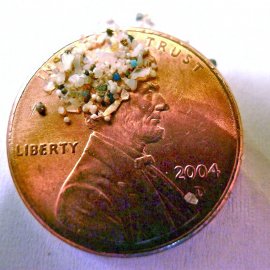Microbeads
-
English
-
ListenPause
I’m Peter Neill, Director of the World Ocean Observatory. Plastic, plastic, plastic, everywhere along our roads, in our streams, in our ponds and lakes, in our coastal wetlands, along our beaches, in vast gyres of accumulated plastic debris as large as islands in the ocean, and finally up and down the ocean in the water column. We have read about this, seen the photographs, and raised our concerns about the impact of plastic on natural ecosystems everywhere. We have recycled certain kinds of plastic packaging; we have boycotted and banned plastic bags; and we have organized community clean-ups, passed ordinances and legislation, made informational films, sailed voyages to attract public attention, and otherwise shouted the evils of non-biodegradable plastic far and wide across the planet. In a recent World Ocean Radio, we pointed out that this plastic lasts for years, that if we could recycle all the plastic extant in the world today we would never have to manufacture another bit of plastic ever to meet demand, thereby leaving all the future requisite fossil fuels in the ground, preventing all the consequential emissions from the atmosphere, and perhaps taking a serious step toward real mitigation of temperature rise, changing weather patterns, ocean acidification, and all the further negative manifestations embodied in plastic that affect our world today. Think about it, a plastic cycle, an independent revolving system of utility re-utilized through reduced demand, product reformation, and alternative behaviors. What a good idea. To understand just how pervasive plastic is in our lives – and just how difficult it will be to implement this good idea, consider the micro-bead: a tiny polyethylene and polypropylene particle, about one half of one millimeter in diameter, that exist by the millions in consumer products such as skin creams and toothpaste that find their way by the millions down drains and into the sewage systems of our towns and cities where they eventually find their way to the ocean. These beads work as exfoliates in deep cleansing beauty creams or in those teeth whitening pastes that suggest a bright white smile. 5 Gyres, an organization dedicated to informing the public about the dangers of plastic pollution, has asserted some products contain between 1 and 5% micro-beads and that one tube of Neutrogena’s “Deep Clean” product contains an estimated 360,000 such particles ultimately loosed into circulation in the name of beauty. The beads float through the waste water network, frequently unfiltered by sewage treatment plants, finding their was into storm drains and run-off, and eventually becoming an invisible manifestation, infestation if you will, of plastic into our natural world. A 2012 5 Gyres study in the Great Lakes, for example, found evidence of more than 600,000 beads per square kilometer. In effect, the beads are a pervasive host for other pollutants like DDT, PCBs, flame-retardants, and other industrial chemicals, become suspended in the water column, and are ingested by various marine species along the food chain, some of which are harvested and consumed by our families. Little good can come of any of this. There are alternatives. Ground apricot shells and cocoa beans are proposed as substitute natural exfoliates for the various products. But if the industry ignores the argument and resists product modification, there is as always the option to legislate a solution. Bills are under consideration in New York, California, and Illinois to ban sale of all micro-bead products in those states. And, as with plastic bags and plastic packaging, those concerned with such detrimental effect can intervene in the market by refusing to purchase these products, advocating to retailers to take the products off the shelves, letting the manufacturers know, testifying in opposition to the inevitable industry lobby in the state legislatures, and joining groups like 5 Gyres to spread the word. In the 1967 classic American film “The Graduate,” the character portrayed by Dustin Hoffman was given one word of certain advice on which to base his future: plastics. It seemed funny, even absurd at the time, but it proved prescient, and almost 50 years later we can now see what that future has become, encased in plastic. We will discuss these issues, and more, in future editions of World Ocean Radio.
Plastic is everywhere: seen and unseen, in wetlands, in swirling gyres of debris, on beaches, and in the water column. In this episode of World Ocean Radio host Peter Neill will discuss just how pervasive plastics have become by describing microbeads, particulates found in exfoliant creams and whitening toothpastes which are flushed, by the billions, down through the waste water network and into rivers, lakes, and ocean.
________________________________________________________________________
Peter Neill, host of World Ocean Radio, provides coverage of a broad spectrum of ocean issues from science and education to advocacy and exemplary projects. World Ocean Radio, a project of the World Ocean Observatory, is a weekly series of brief audio essays available for syndicated use at no cost by community radio stations worldwide. Contact us for more information.
Image Source: Associated Press. Courtesy of 5 Gyres
Educational Resources:
< Thank You Ocean Report: The Microbead Dilemma | YouTube5
< 5Gyres: Beat the Microbead Campaign
< Beat the Microbead App!
- Login to post comments



